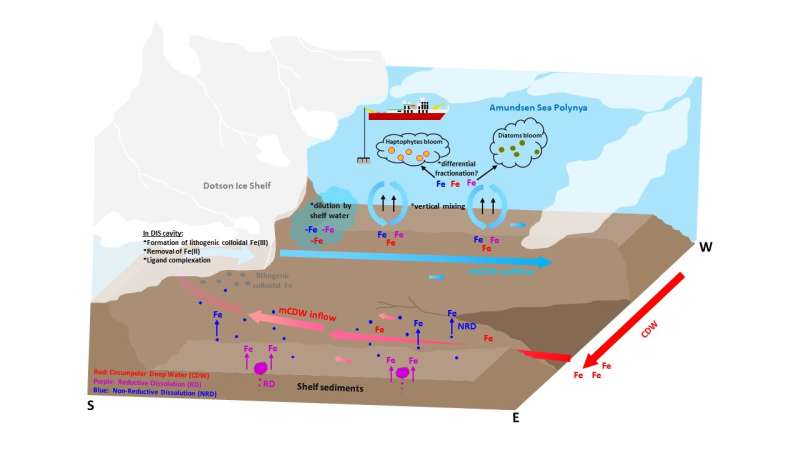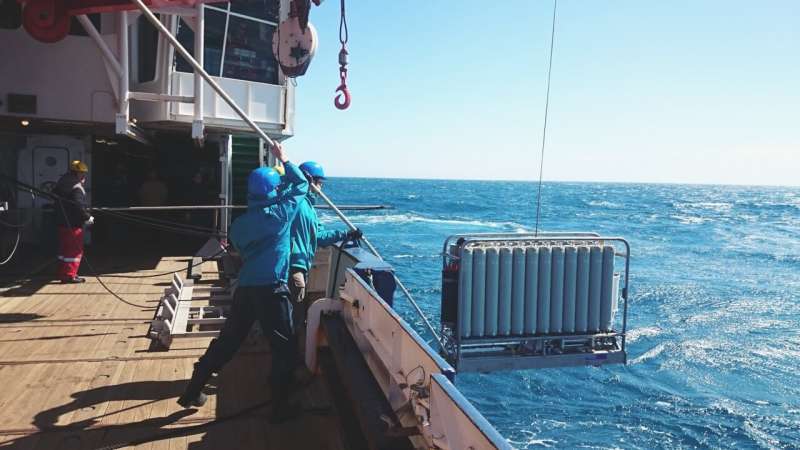Deep sea and sediments bring iron to Antarctic waters, finds researcher
Deep sea and sediments bring iron to Antarctic waters. The iron that fertilizes the waters around Antarctica mostly comes from the deep, upwelling waters and the sediments around the continent.
That conclusion is drawn from field research by NIOZ marine biogeochemist Hung-An Tian in the Amundsen Sea and the Weddell Sea. “Iron plays a pivotal role in the Antarctic ecosystem and potentially also in the climate,” Tian says. “But meanwhile, we still know very little about the exact bookkeeping of iron in the Southern Ocean.” Hung-An Tian defends his Ph.D. thesis on March 15th at Utrecht University.
Iron is a so-called limiting factor for algal growth in the waters around Antarctica. Should there be more iron in the waters, then more algae would come to bloom (and die). They would capture more carbon and maybe store more carbon on the bottom of the ocean.
This has brought daring entrepreneurs in the past to the hypothesis that artificially fertilizing the Southern Ocean with extra iron would capture more carbon and thus solve a little bit of the climate crisis we’re in. Tian warns that, meanwhile, it has been shown this is not as effective or risk-free as initially assumed.
“However, climate change itself also alters the amount of iron naturally supplied to the Southern Ocean, where notably melting glaciers were thought to be an important source. With my research, I’ve been trying to fill some gaps in our knowledge about iron in the Southern Ocean.”
Tian was able to trace back the origins of iron in the Southern Ocean, thanks to isotopes. Iron comes in different chemical forms, such as 54Fe and 58Fe.
“By analyzing the iron isotopes, I was able to fingerprint where iron came from. But that sounds easier said than done. For these analyses I need one to four liters of seawater per sample due to the extremely low concentrations of iron in the Southern Ocean. With 600 samples taken per expedition, I participated in, that means I brought a big container full of Antarctic water back to Texel.”

Upwelling and sinking
Back home at NIOZ, Tian developed a protocol for the analysis of the iron isotopes in this water. “This had never been done before at our institute. It required a lot of hand labor and an extremely clean lab environment and instrumentation. But it was worth it,” he adds.
“I was able to show that in the Amundsen Sea, west of the Antarctic Peninsula, the iron is brought up from the bottom by relatively warm, upwelling water and continental sediments. So far, it was thought that dissolved iron may come from the melting ice shelf, but that mainly contains particulate iron instead of dissolved iron. This combination of iron from upwelled deepwater and sediments is likely to trigger algae to bloom at the surface.”
In the Weddell Sea, east of the Antarctic peninsula, there’s no substantial upwelling. Instead, the dense and salty water that is left behind when (relatively fresh) sea ice is formed sinks to the bottom. “I found lots of iron supplied from the deep sediments in the Weddell Sea, but this iron disappears when the waters are mixed with other water masses in the deep”.
“Thanks to the advanced sampling technology and chemical analysis, we are now on a fast pace to understand how the cycling of iron has changed in the Southern Ocean and how it further influences the climate system,” Tian says. “The more we understand, the more precisely we can predict the positive or negative effects of iron fertilization on the marine environments and climate systems.”
More information:
Thesis defense: www.uu.nl/agenda/promotie-sour … rn-ocean-and-coastal
Citation:
Deep sea and sediments bring iron to Antarctic waters, finds researcher (2024, March 6)
retrieved 6 March 2024
from https://phys.org/news/2024-03-deep-sea-sediments-iron-antarctic.html
This document is subject to copyright. Apart from any fair dealing for the purpose of private study or research, no
part may be reproduced without the written permission. The content is provided for information purposes only.

Deep sea and sediments bring iron to Antarctic waters. The iron that fertilizes the waters around Antarctica mostly comes from the deep, upwelling waters and the sediments around the continent.
That conclusion is drawn from field research by NIOZ marine biogeochemist Hung-An Tian in the Amundsen Sea and the Weddell Sea. “Iron plays a pivotal role in the Antarctic ecosystem and potentially also in the climate,” Tian says. “But meanwhile, we still know very little about the exact bookkeeping of iron in the Southern Ocean.” Hung-An Tian defends his Ph.D. thesis on March 15th at Utrecht University.
Iron is a so-called limiting factor for algal growth in the waters around Antarctica. Should there be more iron in the waters, then more algae would come to bloom (and die). They would capture more carbon and maybe store more carbon on the bottom of the ocean.
This has brought daring entrepreneurs in the past to the hypothesis that artificially fertilizing the Southern Ocean with extra iron would capture more carbon and thus solve a little bit of the climate crisis we’re in. Tian warns that, meanwhile, it has been shown this is not as effective or risk-free as initially assumed.
“However, climate change itself also alters the amount of iron naturally supplied to the Southern Ocean, where notably melting glaciers were thought to be an important source. With my research, I’ve been trying to fill some gaps in our knowledge about iron in the Southern Ocean.”
Tian was able to trace back the origins of iron in the Southern Ocean, thanks to isotopes. Iron comes in different chemical forms, such as 54Fe and 58Fe.
“By analyzing the iron isotopes, I was able to fingerprint where iron came from. But that sounds easier said than done. For these analyses I need one to four liters of seawater per sample due to the extremely low concentrations of iron in the Southern Ocean. With 600 samples taken per expedition, I participated in, that means I brought a big container full of Antarctic water back to Texel.”

Upwelling and sinking
Back home at NIOZ, Tian developed a protocol for the analysis of the iron isotopes in this water. “This had never been done before at our institute. It required a lot of hand labor and an extremely clean lab environment and instrumentation. But it was worth it,” he adds.
“I was able to show that in the Amundsen Sea, west of the Antarctic Peninsula, the iron is brought up from the bottom by relatively warm, upwelling water and continental sediments. So far, it was thought that dissolved iron may come from the melting ice shelf, but that mainly contains particulate iron instead of dissolved iron. This combination of iron from upwelled deepwater and sediments is likely to trigger algae to bloom at the surface.”
In the Weddell Sea, east of the Antarctic peninsula, there’s no substantial upwelling. Instead, the dense and salty water that is left behind when (relatively fresh) sea ice is formed sinks to the bottom. “I found lots of iron supplied from the deep sediments in the Weddell Sea, but this iron disappears when the waters are mixed with other water masses in the deep”.
“Thanks to the advanced sampling technology and chemical analysis, we are now on a fast pace to understand how the cycling of iron has changed in the Southern Ocean and how it further influences the climate system,” Tian says. “The more we understand, the more precisely we can predict the positive or negative effects of iron fertilization on the marine environments and climate systems.”
More information:
Thesis defense: www.uu.nl/agenda/promotie-sour … rn-ocean-and-coastal
Citation:
Deep sea and sediments bring iron to Antarctic waters, finds researcher (2024, March 6)
retrieved 6 March 2024
from https://phys.org/news/2024-03-deep-sea-sediments-iron-antarctic.html
This document is subject to copyright. Apart from any fair dealing for the purpose of private study or research, no
part may be reproduced without the written permission. The content is provided for information purposes only.
